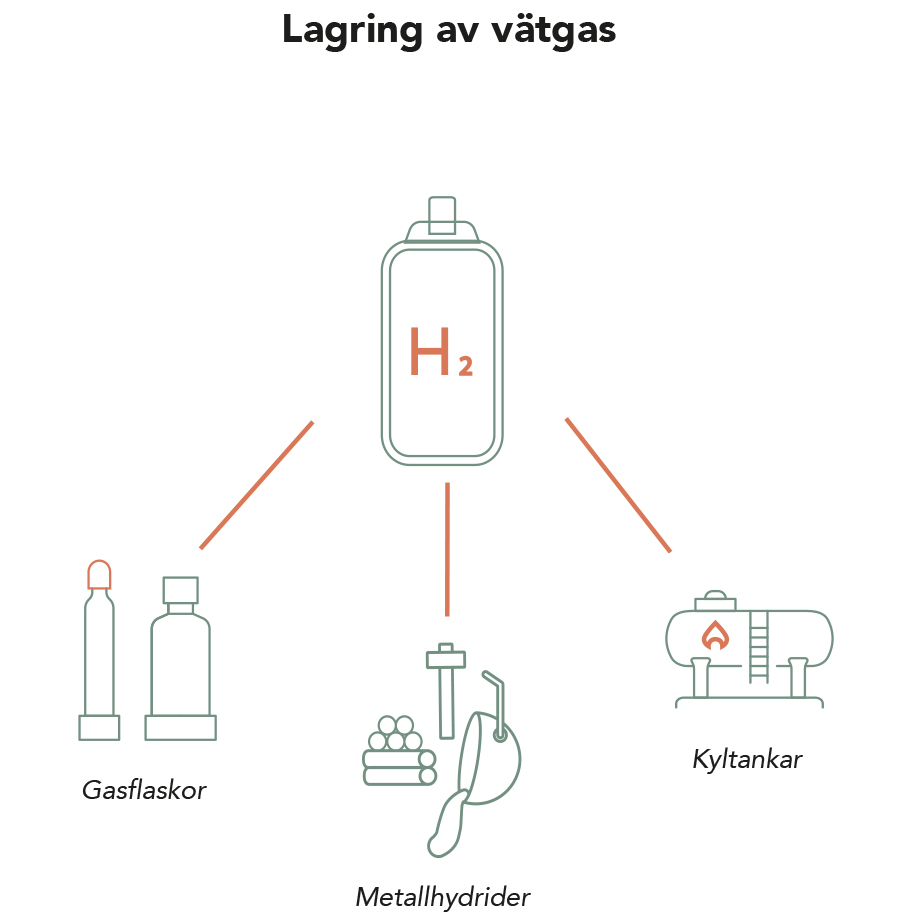One of the major advantages of hydrogen is that it can be stored even for a long time at relatively low cost. The need to be able to store electricity grows as the expansion of renewable energy sources increases.
Sun, wind and wave power are by nature intermittent as energy sources. Meaning more energy is produced than the electricity grid can receive and the energy will go to waste. t other times, the demand for electricity is high, but the supply is low because there is no wind and the sun has set.
If the renewable sources are to become dominant in the energy system, , methods for intermediate storage will be required. Hydrogen can act as a power equalizer and storage for excess energy. Energy systems based on for example wind power, will become more flexible and contribute to increasing the rate of expansion of renewable energy. Storing energy in hydrogen gives the opportunity to store larger amounts of energy than in for example batteries.
Need for renewable energy storage
Large-scale, central energy storage has been used for about a century in the form of water being pumped up to a high-lying dam when electricity is plentiful. Then going through turbines to a lower dam when electricity is scarce (pumped hydro). As electricity production from wind and solar energy increases and the places where water can be pumped in a suitable way for pumping power are severely limited, it becomes even more interesting
to look at alternative storage options.
What characterizes the traditional energy storage methods is high efficiency, but small possibilities to cope with the storage needs required for a transition to an imminent part of renewable electricity. Solar cells and wind power show large variations, not only between day and night but also between several days depending on cloud cover and wind variations.
The focus has therefore shifted from efficiency to storage potential when intermittent (irregular) energy is introduced to a greater degree in the power grids. This seems natural as the electricity generated intermittently is wasted if there is no direct deposit and it is not stored either. If this is the case, the amount of energy that can be stored is more important than the efficiency, since the alternative is that it cannot be used at all when, for example, wind turbines are stopped.
A more decentralized energy storage of intermittent energy sources can partly reduce the strain on the power grid’s capacity, and partly provide the opportunity for energy self-sufficiency for electricity customers.
Hydrogen has an important role to play here because the energy density is high and storage can also take place over longer periods, which is needed in small-scale self-sufficient systems with renewable energy where space is often limited.
Off-grid
With energy-plus buildings and the like, interest in off-grid has increased. The main track for energy storage has then been batteries, which is, however, a relatively expensive storage method if it concerns more than storage for short periods, for example hours.
Hydrogen and fuel cells can provide heat and electricity to buildings. To reduce the vulnerability of the telecommunications network, in connection with storms or other disturbances, this technology can be used in backup power systems for base stations and telephone exchanges.
Fuel cell systems powered by hydrogen only emit water vapor. A fuel cell system does not emit any local pollutants. Therefore, the system is suitable for environments that are sensitive with regard to air quality, such as indoor environments, mines, shelters, nature-sensitive areas, densely populated areas, as well as mobile systems in the event of accidents.
The characteristics of this type of system include: silent operation compared to engine-driven generators, exhaust-free, it can be used in closed spaces, suitable when the environment is valued extra, can be designed for minimal maintenance, can provide long operating time compared to batteries, effective remote monitoring of system condition and fuel storage available.
Energy storage for backup power
As the Swedish electricity grid is very stable with a high uptime, the general need for backup power systems is low. However there are function-critical places where the consequences of a power cut can be great. There, a backup power system is a relatively inexpensive solution to secure functionality such as security, communication and infrastructure.
Cost
Cost calculations show a relatively high cost initially for manufacturing a few storage units. When manufacturing large quantities the unit cost drops quickly. Further cost reduction is expected to be achieved as the fuel cell industry further scales up with more and cheaper components developed for this type of system.

Hydrogen can be stored in several ways
- Gas cylinders: hydrogen is compressed to 30-700 bar pressure and stored in gas cylinders. Gas cylinders can hold from a few liters to thousands of cubic meters depending on the application.
- Cooling tanks: Hydrogen that is stored in liquid form first needs to be cooled down to -253 degrees Celsius. This process requires about 10-20% of the energy content, meaning it only pays off for relatively longdistance transports, or if the end user needs liquid hydrogen. Such an end user could be aircraft with either fuel cells and electric motors or jet engines powered by hydrogen. Liquid hydrogen is not usually distributed in Sweden, the closest market is Germany.
- Metal hydrides: hydrogen can be stored in some metals under pressure. The method yields a relatively high energy content, but the metal hybrids are heavy, which makes them unsuitable for transport applications, they are mainly used in submarines. Metal hydrides are an active area of research where the goal is to multiply the hydrogen storage capacity per unit weight to become competitive with pressurized hydrogen in more applications.
















